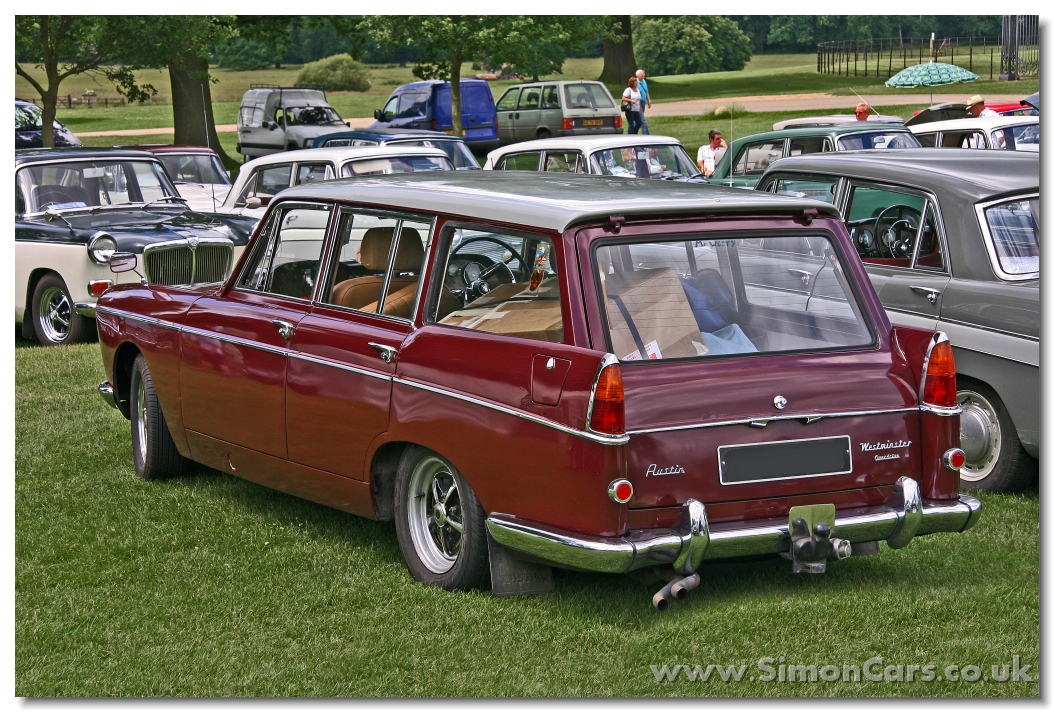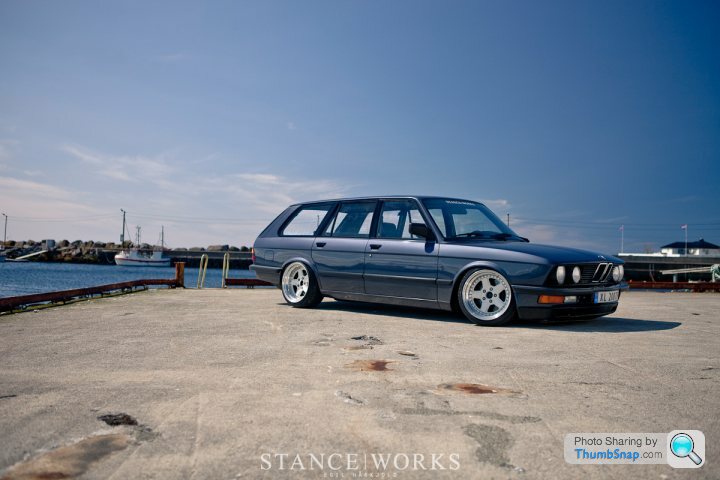RE: BMW 3.0Si Estate: Spotted
Discussion
The saloon is one of the all-time classics to me, perfect poise and proportions, especially as the 3.0Si.
Didn’t Millenium Heros have a metallic brown 3.3LiA for sale at circa £89k recently? Bonkers money.
Not sure about this estate, the proportions are fine it’s the rear side glass that doesn’t gel to me, almost like they forgot about ‘tumblehome’ (now there’s a phrase I don’t see any more, so I’ll use it again..tumblehome!)
How would one insure it? Obviously an agreed value through a very knowledgeable insurer but I can’t imagine how you would source parts in the case of accident damage, and the cost for a specialist to rebuild it would be astronomical.
On that premise i’d stick with the saloon, even over a 3.0 CSi or CSL
Didn’t Millenium Heros have a metallic brown 3.3LiA for sale at circa £89k recently? Bonkers money.
Not sure about this estate, the proportions are fine it’s the rear side glass that doesn’t gel to me, almost like they forgot about ‘tumblehome’ (now there’s a phrase I don’t see any more, so I’ll use it again..tumblehome!)
How would one insure it? Obviously an agreed value through a very knowledgeable insurer but I can’t imagine how you would source parts in the case of accident damage, and the cost for a specialist to rebuild it would be astronomical.
On that premise i’d stick with the saloon, even over a 3.0 CSi or CSL
cookie1600 said:
I might have the model wrong but was certainly led to believe they came from a big Austin. The first cars used a Ford Taunus tailgate I believe, but later UK cars were built by Crayford (the same people who were the first UK Alpina dealers and chopped the roof off Cortinas) and it was they who used the Austin tailgate. I'm happy to be corrected though, as this was just stuff I was told a good few years ago and my memory isn't that great. 
Just found this whilst trying to see if I was right about tailgate. Interesting read and kind of justifies that £80K price tag.
[i] David Maughan is a car guy, drawn unreservedly to the lines and engineering of German cars – BMW and Porsche in particular. “When I saw my first #BMW-E3 it blew me away,” David enthuses. Apparently, his mother claimed his fascination for cars came from the fact that while she was pregnant with David she also took her driving test, a gene thing, perhaps. Later, aged 17, he was given £50 to buy a car. “Like most youngsters my passion was for speed, but I ended up buying a Mini 850,” he continues. “Later, while my father was driving a BMC 1800 ‘Land Crab’, I saw one of the very first 2500 E3s in the UK. Later, the 1972 TV series Man at the Top featured a BMW 3.0Si, some of the filming being done outside our home in West London. It was a clever marketing ploy by BMW UK to promote the car as a top drawer executive saloon.” For David, at least, it had the desired effect.
Sometime later Classic & Sportscar magazine featured a 3.0Si tested against an equivalent Mercedes, motor-noter Martin Buckley proclaiming the BMW to be the preferred machine. When the car then came up for sale at a BMW specialist in East Sussex David bought it without hesitation; he still has it. David’s introduction to BMW E3 Estate cars came in 1994 through an advertisement. “The car was reckoned to be the Team Alpina tow car,” says David. “While I can’t vouch for that I can say that its first owner was King Constantine of Greece. The opportunity was too good to miss. Sadly, when I went to collect it the car was a mess. The spare wheel well, the floor, the interior; it was too far gone. But it did launch me on my quest for an E3 Estate.”
The story behind these unusual cars could be said to have started by the salvation of the company by Dr Herbert Quandt in 1959 and the programme to rejuvenate BMW models. The BMW Board was joined by Paul Hofmeister who focused the range on reaching a niche market while driving up exports. Before long BMW was successfully combining exclusivity with competition charisma. The 700 Series and the larger Neue Klasse saloons could be seen on events such as the Monte Carlo Rally and the Saloon Car Championships rounds. Meanwhile, the company’s competition department, set up in the main factory, was developing Formula 2 cars using, first, a Lola chassis powered by a highly modified M10 engine. Privateers and outside companies like Alpina and Schnitzer were compounding competition successes. Toward the end of the decade, to transport the cars from circuit-to-circuit BMW’s competition workshops arranged for three estate cars to be built based on the recently-launched E3. Meanwhile a small workshop for the rally department was set up at Pension Preußenstraße in Leipzig.
The first E3s were the 2500 and the 2800 saloons arriving in the UK in time for the 1969 sales year, the larger engined model benefitting from an improved trim level. Both power units shared the same design – a chain-driven overhead camshaft six-cylinder engine. Its smooth running was the result of seven main bearings. Carburetion was provided by two twin-choke Solex/Zeniths feeding a cylinder head with hemispherical combustion chambers. Transmission was either a four-speed manual ‘box or a three-speed automatic, both well suited to the engine’s characteristics. Suspension utilised MacPherson struts at the front and independent trailing arms at the rear. On release the E3s set a new benchmark for top end luxury performance cars aimed at senior executives who enjoyed driving themselves. After the near-collapse of the company less than ten years before, the range was an astonishing achievement. Yet, there was more to come; a #M30 / #M30B30 3.0-litre car followed soon after drawing breath through carburettor induction while the flagship fuel injected 3.0Si followed in 1971. As tested by Autocar, with a 0-60 time of 7.3 seconds and a top speed of 131mph this version was truly a breathtakingly quick car for its day.
However, it was the 3.0-litre versions that provided the platform for the competition estates, known around the factory as Kombis. Three estates were built. In the cockpit only the front seats were fitted with a grill behind to prevent tools and spares from flying forward in the event of heavy braking. In the rear was a flat panelled area which would be turned into a sleeping facility when the mechanics stopped for the night. A substantial roof rack was added taking spare wheels and tyres. The rear side windows were perspex while the tailgates are thought to have come from the Ford Taunus, adapted by seam welding it to the upright section of the bootlid complete with lock; overall, it was a very neat job.
Over their five year career the Kombis were used as tow vehicles for both racing and rallying, ex-team mechanics recalling long hauls between rallies such as the Acropolis, the 1000 Lakes and the Monte Carlo. On one occasion a car was so over-laden that the alloy wheels, which were retrospectively fitted from the 3.0Si, cracked and collapsed. Significantly, as workhorses they proved ideal transport. Yet, BMW’s marketing team had no feelings or favouritism for the estate theme in their mainstream model line-up; if there was a hunting, shooting or fishing fraternity in Germany it was not considered worthy of satisfying their demands with a suitable vehicle; the three Kombis remained unique.
From the outset BMW’s sales structure in the UK was an autonomous operation. By 1969 BMW Concessionaires (GB) Ltd was operated by Peter Beaumont, Raymond Playfoot and Peter Samuelson as an independent company owned by investment organisation (now part of the Inchcape group) Tozer, Kemsley, Milbourn Ltd. The 1960s was a period of consolidation for the BMW marque in the UK, with dealers being established around the country and 1788 cars were sold during 1969. In 1970 the numbers sold leapt to 3028, a trend which would multiply several times over during the decade.
With this growth rate and the freedom to pursue their own marketing strategy a plan was conceived to offer an estate version of the E3, encouraged no doubt by the Kombis, which would have been seen around the international race and rally venues. A specification was drawn up, which included extending the roof, fitting a tailgate and retrimming the boot area. To make the package more attractive the client brochure offered several extras including a sunroof, a dog guard, a rubber mat covering the load area and a tow bar. The introduction of the Rover P6 Estate called the ‘Estoura’ in 1969, built by FLM Panelcraft and tested by Autocar, will have influenced the BMW UK concessionaires still further in their notion to introduce an estate version of the E3.
FLM Panelcraft had been founded in the early 1950s. Based in Battersea, South London, FLM took its initials from the company founders, Messrs Fry, Lee and McNally, employing craftsmen from the declining coachbuilding industry, most notably James Young. They began by restoring and converting prewar Rolls-Royces and Bentleys. The company then embarked on a series of estate car conversions of contemporary upmarket saloons, part of this work being under sub-contract to another well known coachbuilding specialist, Crayford, based in Westerham, Kent whose name was already linked to turning BMC and Ford saloons into convertibles.
Sadly, it’s clear today that these Panelcraft Estates were built down to a price using pop-rivets for joining the roof’s sections, lead loaded and covered with vinyl, panels being positioned over existing bodywork with no attempt at rust proofing. Having adapted the bodyshell the work of trimming was passed to Crayford, H R Owen or Hurst Park Motors, which would account for the subtle differences between the cars. From David’s experience the conversions carried out on BMW E3s also suffered from poor workmanship: “When I went to collect my first E3 estate I could see that the trim was incredibly crudely done; the conversion was mostly based on removing the rear scuttle, adding the roof and adapting the seat fixings with a bit of carpet. I was very disappointed. However, I took the view that there were probably more so it was eventually scrapped.”
David’s second estate was supplied originally by Shirley’s of Croydon, South London. “Judging by the registration details I think the dealers gave the owner a copy of the brochure and he had it converted later, in 1981,” continues David. “I bought it in 1995 and again it was in a very sorry state. At the time I was talking to a restorer in Ireland and I was persuaded to send them the BMW and they did all the strip-out work. It had a metal sunroof and when we took the vinyl off we found that where the additional estate roof section met the original panel it had been leadfilled and pop-riveted. We ended up putting a complete new roof on and respraying it Polaris silver.
But I began to realise it could never be restored to the quality I wanted and the project stalled.” But, David was still not done. In 2001 he saw another E3 estate for sale and decided, no matter what its condition, he would buy it to produce patterns. “For example the glass in the rear was specially cut. It, too, was crated up and sent off to the Ireland. Again, we took everything off worth saving and then the car was scrapped.”
It was some years later when David read about a company who specialised in high end BMW restorations based just outside Chicago called ‘The Werk Shop’. “I knew it would prepare the car to the quality I wanted so, in 2008 it was placed in a container and sent over.”
With the car unloaded the Chicago team began to evaluate the true measure of the task they’d been given. The predicament was whether to restore it to Panelcraft’s standards, or to undertake a thorough job. In the event David chose the latter route. Three doors, a rear wing panel and the inner and outer sills were all replaced while the tailgate required considerable fettling. But it was the interior trim which posed the conundrum. Not to be disappointed with the end result, David specified blue leather seats with matching quality carpeting.
David found his fourth Estate car while browsing through eBay. “In 1973 Anton Hille, the UK concessionaires MD, formed a team with Tony Lanfranchi as competition/team manager and four competition 3.0Si saloons were built by Mathwall Engineering. Three were entered in the 1973 Avon Tour of Great Britain. The drivers were Roger Bell,Tony Lanfranchi and Mike Woolley. The team was based in West London and they used an E3 estate as a tow car. Those who remember the car recall it was a 3.0SA in white with a blue roof. The guys in Chicago said buy it, so in 2008 that went off to the States as well.”
Today, David’s beloved E3, (his second in chronological order of purchase) is back in the UK with a little detailing yet to be done, and is in the capable hands of Barney Halse at Classic Heroes. “Through lots of research I know of nine-ten E3 Estates, which includes a recently discovered car in the West Country.”
So, does the car live up to David’s exacting standards? “The drivetrain has been rebuilt and all the suspension components replaced,” he replies. “Overall, it’s covered around 60 miles, long enough for me to become acquainted with its strengths and foibles. E3 saloons were only blessed with average torsional rigidity for the day so converting one into an estate leads to greater flexing, which you can feel when it’s driven over our potholed B-roads or uneven surfaces. I may have a removable strutbrace fitted linking the twin rear suspension turrets. Other than that I’m very pleased with the result.”
As for the Kombis, in #1974 they were disposed of and replaced by larger transporters more suited to the task. Only one has survived. The last of the trio to be built was actually bought by one of the BMW mechanics who had driven it in haste from event to event. He rebuilt it, the task including a complete body strip and respray in BMW’s competitions livery of white and sea blue. It was then sold to a UK-based #BMW specialist.
The estate conversion could be ordered when new or even at a later date. [/i]
[i] David Maughan is a car guy, drawn unreservedly to the lines and engineering of German cars – BMW and Porsche in particular. “When I saw my first #BMW-E3 it blew me away,” David enthuses. Apparently, his mother claimed his fascination for cars came from the fact that while she was pregnant with David she also took her driving test, a gene thing, perhaps. Later, aged 17, he was given £50 to buy a car. “Like most youngsters my passion was for speed, but I ended up buying a Mini 850,” he continues. “Later, while my father was driving a BMC 1800 ‘Land Crab’, I saw one of the very first 2500 E3s in the UK. Later, the 1972 TV series Man at the Top featured a BMW 3.0Si, some of the filming being done outside our home in West London. It was a clever marketing ploy by BMW UK to promote the car as a top drawer executive saloon.” For David, at least, it had the desired effect.
Sometime later Classic & Sportscar magazine featured a 3.0Si tested against an equivalent Mercedes, motor-noter Martin Buckley proclaiming the BMW to be the preferred machine. When the car then came up for sale at a BMW specialist in East Sussex David bought it without hesitation; he still has it. David’s introduction to BMW E3 Estate cars came in 1994 through an advertisement. “The car was reckoned to be the Team Alpina tow car,” says David. “While I can’t vouch for that I can say that its first owner was King Constantine of Greece. The opportunity was too good to miss. Sadly, when I went to collect it the car was a mess. The spare wheel well, the floor, the interior; it was too far gone. But it did launch me on my quest for an E3 Estate.”
The story behind these unusual cars could be said to have started by the salvation of the company by Dr Herbert Quandt in 1959 and the programme to rejuvenate BMW models. The BMW Board was joined by Paul Hofmeister who focused the range on reaching a niche market while driving up exports. Before long BMW was successfully combining exclusivity with competition charisma. The 700 Series and the larger Neue Klasse saloons could be seen on events such as the Monte Carlo Rally and the Saloon Car Championships rounds. Meanwhile, the company’s competition department, set up in the main factory, was developing Formula 2 cars using, first, a Lola chassis powered by a highly modified M10 engine. Privateers and outside companies like Alpina and Schnitzer were compounding competition successes. Toward the end of the decade, to transport the cars from circuit-to-circuit BMW’s competition workshops arranged for three estate cars to be built based on the recently-launched E3. Meanwhile a small workshop for the rally department was set up at Pension Preußenstraße in Leipzig.
The first E3s were the 2500 and the 2800 saloons arriving in the UK in time for the 1969 sales year, the larger engined model benefitting from an improved trim level. Both power units shared the same design – a chain-driven overhead camshaft six-cylinder engine. Its smooth running was the result of seven main bearings. Carburetion was provided by two twin-choke Solex/Zeniths feeding a cylinder head with hemispherical combustion chambers. Transmission was either a four-speed manual ‘box or a three-speed automatic, both well suited to the engine’s characteristics. Suspension utilised MacPherson struts at the front and independent trailing arms at the rear. On release the E3s set a new benchmark for top end luxury performance cars aimed at senior executives who enjoyed driving themselves. After the near-collapse of the company less than ten years before, the range was an astonishing achievement. Yet, there was more to come; a #M30 / #M30B30 3.0-litre car followed soon after drawing breath through carburettor induction while the flagship fuel injected 3.0Si followed in 1971. As tested by Autocar, with a 0-60 time of 7.3 seconds and a top speed of 131mph this version was truly a breathtakingly quick car for its day.
However, it was the 3.0-litre versions that provided the platform for the competition estates, known around the factory as Kombis. Three estates were built. In the cockpit only the front seats were fitted with a grill behind to prevent tools and spares from flying forward in the event of heavy braking. In the rear was a flat panelled area which would be turned into a sleeping facility when the mechanics stopped for the night. A substantial roof rack was added taking spare wheels and tyres. The rear side windows were perspex while the tailgates are thought to have come from the Ford Taunus, adapted by seam welding it to the upright section of the bootlid complete with lock; overall, it was a very neat job.
Over their five year career the Kombis were used as tow vehicles for both racing and rallying, ex-team mechanics recalling long hauls between rallies such as the Acropolis, the 1000 Lakes and the Monte Carlo. On one occasion a car was so over-laden that the alloy wheels, which were retrospectively fitted from the 3.0Si, cracked and collapsed. Significantly, as workhorses they proved ideal transport. Yet, BMW’s marketing team had no feelings or favouritism for the estate theme in their mainstream model line-up; if there was a hunting, shooting or fishing fraternity in Germany it was not considered worthy of satisfying their demands with a suitable vehicle; the three Kombis remained unique.
From the outset BMW’s sales structure in the UK was an autonomous operation. By 1969 BMW Concessionaires (GB) Ltd was operated by Peter Beaumont, Raymond Playfoot and Peter Samuelson as an independent company owned by investment organisation (now part of the Inchcape group) Tozer, Kemsley, Milbourn Ltd. The 1960s was a period of consolidation for the BMW marque in the UK, with dealers being established around the country and 1788 cars were sold during 1969. In 1970 the numbers sold leapt to 3028, a trend which would multiply several times over during the decade.
With this growth rate and the freedom to pursue their own marketing strategy a plan was conceived to offer an estate version of the E3, encouraged no doubt by the Kombis, which would have been seen around the international race and rally venues. A specification was drawn up, which included extending the roof, fitting a tailgate and retrimming the boot area. To make the package more attractive the client brochure offered several extras including a sunroof, a dog guard, a rubber mat covering the load area and a tow bar. The introduction of the Rover P6 Estate called the ‘Estoura’ in 1969, built by FLM Panelcraft and tested by Autocar, will have influenced the BMW UK concessionaires still further in their notion to introduce an estate version of the E3.
FLM Panelcraft had been founded in the early 1950s. Based in Battersea, South London, FLM took its initials from the company founders, Messrs Fry, Lee and McNally, employing craftsmen from the declining coachbuilding industry, most notably James Young. They began by restoring and converting prewar Rolls-Royces and Bentleys. The company then embarked on a series of estate car conversions of contemporary upmarket saloons, part of this work being under sub-contract to another well known coachbuilding specialist, Crayford, based in Westerham, Kent whose name was already linked to turning BMC and Ford saloons into convertibles.
Sadly, it’s clear today that these Panelcraft Estates were built down to a price using pop-rivets for joining the roof’s sections, lead loaded and covered with vinyl, panels being positioned over existing bodywork with no attempt at rust proofing. Having adapted the bodyshell the work of trimming was passed to Crayford, H R Owen or Hurst Park Motors, which would account for the subtle differences between the cars. From David’s experience the conversions carried out on BMW E3s also suffered from poor workmanship: “When I went to collect my first E3 estate I could see that the trim was incredibly crudely done; the conversion was mostly based on removing the rear scuttle, adding the roof and adapting the seat fixings with a bit of carpet. I was very disappointed. However, I took the view that there were probably more so it was eventually scrapped.”
David’s second estate was supplied originally by Shirley’s of Croydon, South London. “Judging by the registration details I think the dealers gave the owner a copy of the brochure and he had it converted later, in 1981,” continues David. “I bought it in 1995 and again it was in a very sorry state. At the time I was talking to a restorer in Ireland and I was persuaded to send them the BMW and they did all the strip-out work. It had a metal sunroof and when we took the vinyl off we found that where the additional estate roof section met the original panel it had been leadfilled and pop-riveted. We ended up putting a complete new roof on and respraying it Polaris silver.
But I began to realise it could never be restored to the quality I wanted and the project stalled.” But, David was still not done. In 2001 he saw another E3 estate for sale and decided, no matter what its condition, he would buy it to produce patterns. “For example the glass in the rear was specially cut. It, too, was crated up and sent off to the Ireland. Again, we took everything off worth saving and then the car was scrapped.”
It was some years later when David read about a company who specialised in high end BMW restorations based just outside Chicago called ‘The Werk Shop’. “I knew it would prepare the car to the quality I wanted so, in 2008 it was placed in a container and sent over.”
With the car unloaded the Chicago team began to evaluate the true measure of the task they’d been given. The predicament was whether to restore it to Panelcraft’s standards, or to undertake a thorough job. In the event David chose the latter route. Three doors, a rear wing panel and the inner and outer sills were all replaced while the tailgate required considerable fettling. But it was the interior trim which posed the conundrum. Not to be disappointed with the end result, David specified blue leather seats with matching quality carpeting.
David found his fourth Estate car while browsing through eBay. “In 1973 Anton Hille, the UK concessionaires MD, formed a team with Tony Lanfranchi as competition/team manager and four competition 3.0Si saloons were built by Mathwall Engineering. Three were entered in the 1973 Avon Tour of Great Britain. The drivers were Roger Bell,Tony Lanfranchi and Mike Woolley. The team was based in West London and they used an E3 estate as a tow car. Those who remember the car recall it was a 3.0SA in white with a blue roof. The guys in Chicago said buy it, so in 2008 that went off to the States as well.”
Today, David’s beloved E3, (his second in chronological order of purchase) is back in the UK with a little detailing yet to be done, and is in the capable hands of Barney Halse at Classic Heroes. “Through lots of research I know of nine-ten E3 Estates, which includes a recently discovered car in the West Country.”
So, does the car live up to David’s exacting standards? “The drivetrain has been rebuilt and all the suspension components replaced,” he replies. “Overall, it’s covered around 60 miles, long enough for me to become acquainted with its strengths and foibles. E3 saloons were only blessed with average torsional rigidity for the day so converting one into an estate leads to greater flexing, which you can feel when it’s driven over our potholed B-roads or uneven surfaces. I may have a removable strutbrace fitted linking the twin rear suspension turrets. Other than that I’m very pleased with the result.”
As for the Kombis, in #1974 they were disposed of and replaced by larger transporters more suited to the task. Only one has survived. The last of the trio to be built was actually bought by one of the BMW mechanics who had driven it in haste from event to event. He rebuilt it, the task including a complete body strip and respray in BMW’s competitions livery of white and sea blue. It was then sold to a UK-based #BMW specialist.
The estate conversion could be ordered when new or even at a later date. [/i]
e30m3Mark said:
Just found this whilst trying to see if I was right about tailgate. Interesting read and kind of justifies that £80K price tag.
A great read and thank you for adding all that extra info, it certainly is an eye opener to the original build 'quality'. As mentioned above, I also concluded it was an Austin Maxi tailgate but comparing the two, you couldn't really recognise much similarity other than the back window itself.I have a passing interest in Crayford Conversions and there is a wealth of info out there including a Pistonheads thread on a Mercedes Benz W114 estate of a similar vintage to the BMW in this thread:
https://www.pistonheads.com/gassing/topic.asp?t=16...
or here:

https://www.pistonheads.com/gassing/topic.asp?h=0&...
Have a look at that rear side window and it looks as uncomfortable as the BMW one. In fact they look to be almost the same.
Moving on to other Crayford estates (as opposed the convertibles they were more widely known for) and in connection with the Austin theme, what about this out of proportion monster Austin 3 Litre:

http://www.austinthreelitre.co.uk/estate/default.h...
See the rear side window again and the ever present vinyl roof probably covering a multitude of sins?
Talking of which, the Rover P6 conversion Crayford (or FLM Panelcraft!) did was not happy looking:

https://www.aronline.co.uk/cars/rover/p6/crayford-...
I think they must have had a job lot of side windows and a whole roll of vinyl to hide the cut and shuts.
This 450 SEL estate also apparently by Crayford doesn't really look a cohesive fulfilment either:
At least there's no vinyl roof on that one.
If you want to go for some really ungainly estate conversions, how about the Crayford Tracer?

Or the Avon Coachworks Jaguar/Daimlers, with Renault 5 rear hatch?


https://www.aronline.co.uk/cars/jaguar/xj6-xj12/av...
Or this unfortunate Bentley 'add on'

Such a shame when somebody like Lynx could create (and I think enhance) the XJS as the Eventer:
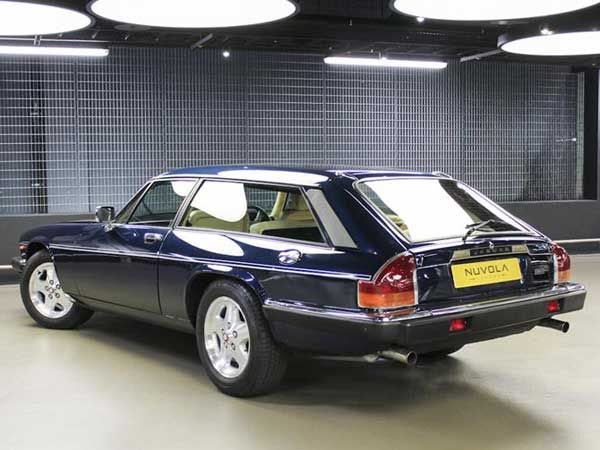

Edited by cookie1600 on Tuesday 30th January 14:24
It might be doing an injustice to firms like FLM Panelcraft and or Harold Radford when considering the methods of build they employed. Certainly trying to join two huge steel panels together by welding would have caused severe buckling or warping and you'd never really get the thing to look right. Making a whole new section, front to rear is the way to go but in those days, with costs to consider, pop-riveting two large panels was probably the only viable option.
Not rustproofing or painting the chopped halves was a definite oversight and the fact that many estate conversions ended up with vinyl roofs, also says a lot about the finish they were achieving, even with lead loading. I must admit some of the Aston and Rolls Royce work they did looked pretty good though:

No vinyl there and I suspect it's a full new roof front to back, but this DBS conversion whilst not unpleasant in proportions, looks a bit 'Harold and Maud' and sports the infamous vinyl cover up under the dodgy roof rack:
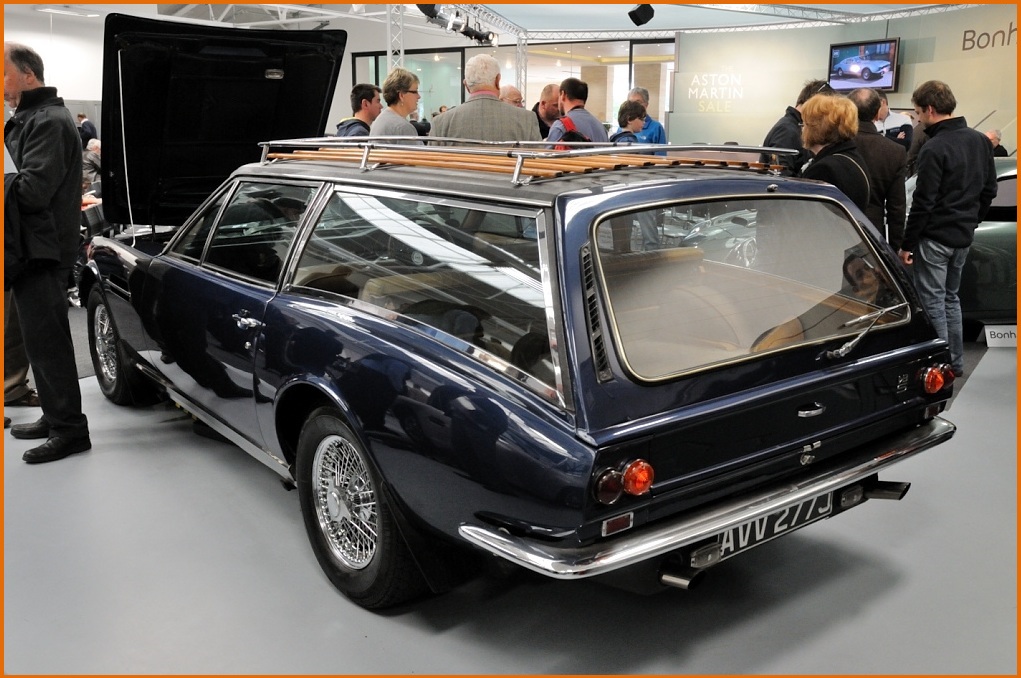
http://www.dbsvantage.com/en/pages/production/shoo...
This Silver Shadow conversion by FLM almost pulls it off, by like a lot of other estates based on this model, the rear top door slopes back quite a bit as a saloon, so no full height rear side window is ever going to look great:


Vinyl roof employed again for covering up anything dodgy.
Possibly the most Marmite of estate conversions was the Harold Radford Silver Cloud, which as an outline looks great, but that top rear doorline?

But do you know what, I actually quite like it and have done for about 40 years when I tired to track down the two examples that were built and were in America at the time.
Not rustproofing or painting the chopped halves was a definite oversight and the fact that many estate conversions ended up with vinyl roofs, also says a lot about the finish they were achieving, even with lead loading. I must admit some of the Aston and Rolls Royce work they did looked pretty good though:

No vinyl there and I suspect it's a full new roof front to back, but this DBS conversion whilst not unpleasant in proportions, looks a bit 'Harold and Maud' and sports the infamous vinyl cover up under the dodgy roof rack:

http://www.dbsvantage.com/en/pages/production/shoo...
This Silver Shadow conversion by FLM almost pulls it off, by like a lot of other estates based on this model, the rear top door slopes back quite a bit as a saloon, so no full height rear side window is ever going to look great:


Vinyl roof employed again for covering up anything dodgy.
Possibly the most Marmite of estate conversions was the Harold Radford Silver Cloud, which as an outline looks great, but that top rear doorline?

But do you know what, I actually quite like it and have done for about 40 years when I tired to track down the two examples that were built and were in America at the time.
e30m3Mark said:
Just found this whilst trying to see if I was right about tailgate.
And more about the conversion and restoration here:It’s not bad, but you can definitely feel the lack of structural rigidity, along with the weight that was added at the rear when BMW’s U.K. distributor (and Langley Motors of Surbiton, Surrey, which handled customer orders) enlisted Crayford Engineering of Westerham, Kent to alter the bodywork of its flagship sedan.
Paying the price for cutting costs
“It’s speculation, but Crayford most likely underbid to get the job,” says The Werk Shop’s David Masi, who supervised the restoration. “Their original sheet metal work in the rear greenhouse, especially at the roof, was average by the standard of the time in England, which means pretty poor.”
To change the E3 from a sedan to an estate meant converting a car with a trunk into one with an extended roof and a top-hinged tailgate. The latter was sourced from the aforementioned Austin Maxi five-door hatch and extended with seven inches of E3 trunk lid.
“The Maxi tailgate became the end of the conversation, and it dictated the slope of the roof and the shape of the greenhouse,” Masi says.
The design seems less than ideal, declining as it moves rearward. “Kind of like 1970s Britain!” Masi quips.
The Crayford method does indeed seem the product of a crude industry, more like something that would have been done in the 1950s than the mid-’70s. The hand-made hinges in cast aluminum are ”very roughly filed, with not a straight line on them,” Masi says.
“Another cost-cutting idea was to make the rear side glass flat instead of curved,” he explains. “But the opening the flat glass is supposed to fit into isn’t flat, as we discovered when working with a glazier to fit them.”
The interior elements of the Crayford conversion reveal further shortcuts.
“Basically, except for the metal structure, most of the interior trimming was completely unworkable,” Masi says. “They cut the rear bulkhead out of the sedan to hollow out the back of the car, losing a bit of structure. And because there’s no bulkhead, the rear seat back becomes the bulkhead.”
Crayford had made its rear seat back out of plywood, which The Werk Shop did, as well. This time, though, the part was cut with much tighter tolerances.
“You could stick your hand between the seat and the wheel arch!” Masi says of the original. “Our trimmer cut new seat boards and made the clearances much tighter to make it look more finished.”
https://www.bimmer-mag.com/issues/114/articles/ecc...
More testament to FLM Panelcraft's conversion work and how they interacted with Crayford here, describing the Rover P6 Estoura:
According to P6 archivist John Windwood, Crayford’s involvement in the project was limited to the interior of the car, and the company had no bearing on the external design of the estate conversion: ‘These vehicles were designed and built by FLM Panelcraft. FLM converted the basic shells, and the interiors and cosmetics were then fitted by either Crayford, HR Owen or Hurst Park Motors. This explains the various internal and external differences between surviving examples. Crayford apparently began to badge their estates as Crayfords and implied that they built them. They were forced to stop when FLM threatened legal action.’
What’s more, the quality of the conversion also left a great deal to be desired. According to John Windwood: ‘Due to the sloping roofline, the rear door is very low and very small; I am 6ft 2in tall, and the tailgate is open fully at about the level of my chest! ‘Loadspace is also compromised for the same reason. And they were even more rot-prone than the standard P6 because the conversion was, quite frankly, a bit of a lash-up! The rear pod unit is basically held onto the base unit with pop rivets, and when the cars were cut for conversion, no paint or other rustproofing was applied to the bare edges. The rear pod was also fitted on top of the boot drain channels, effectively blocking them and redirecting the water to places it was never intended to go.’
https://www.aronline.co.uk/cars/rover/p6/crayford-...
According to P6 archivist John Windwood, Crayford’s involvement in the project was limited to the interior of the car, and the company had no bearing on the external design of the estate conversion: ‘These vehicles were designed and built by FLM Panelcraft. FLM converted the basic shells, and the interiors and cosmetics were then fitted by either Crayford, HR Owen or Hurst Park Motors. This explains the various internal and external differences between surviving examples. Crayford apparently began to badge their estates as Crayfords and implied that they built them. They were forced to stop when FLM threatened legal action.’
What’s more, the quality of the conversion also left a great deal to be desired. According to John Windwood: ‘Due to the sloping roofline, the rear door is very low and very small; I am 6ft 2in tall, and the tailgate is open fully at about the level of my chest! ‘Loadspace is also compromised for the same reason. And they were even more rot-prone than the standard P6 because the conversion was, quite frankly, a bit of a lash-up! The rear pod unit is basically held onto the base unit with pop rivets, and when the cars were cut for conversion, no paint or other rustproofing was applied to the bare edges. The rear pod was also fitted on top of the boot drain channels, effectively blocking them and redirecting the water to places it was never intended to go.’
https://www.aronline.co.uk/cars/rover/p6/crayford-...
I should love this, but I don't. It's an historic oddity, and thank goodness someone was bothered to preserve it, but it's nothing like as nice as the aforementioned Austin Westminster conversion, for example - it has an unfortunate case of Estoura-itis (a.k.a. FLM Panelcraft P6 droopy-arse syndrome!). I have a real dislike of such conversions where they reuse the edge of the saloon's bootlid, giving that step in the back. Worse still was this E12:
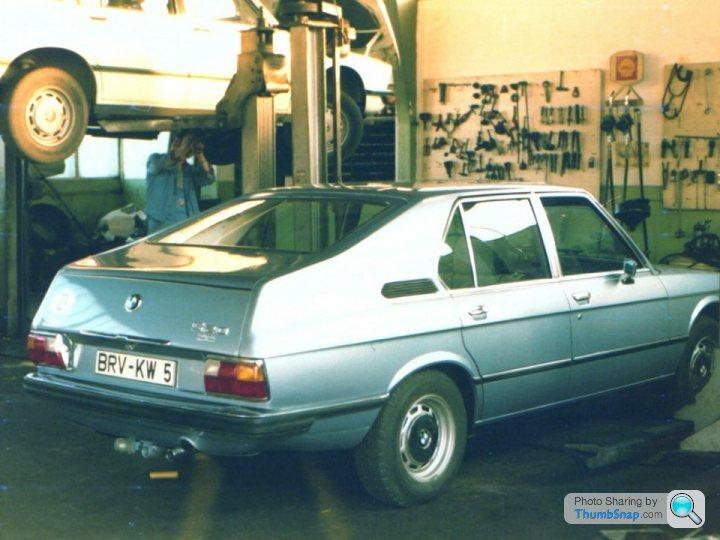
...which, alas, still exists. https://www.drive2.com/b/253873/
This E23 7-series Touring is OK, though the parallel double Hofmeister kink makes my OCD itch. I really like how neatly the wiper has been integrated.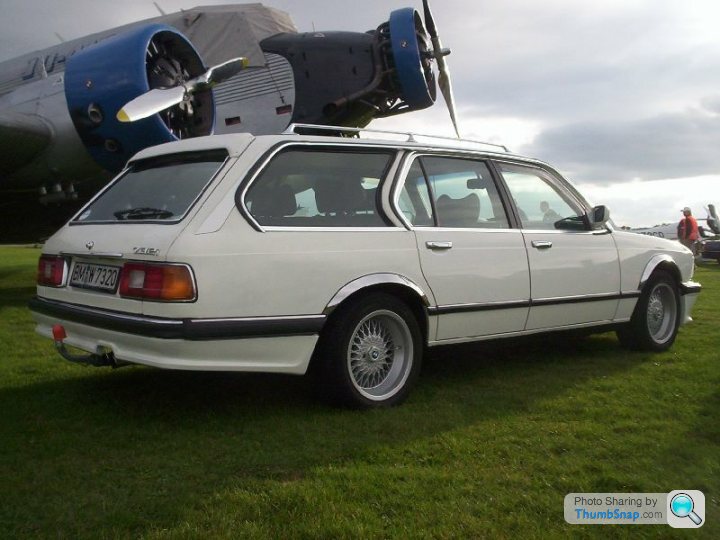
Schulz did some rather good E28 5-series Tourings, none of which has a factory-looking wiper, alas.
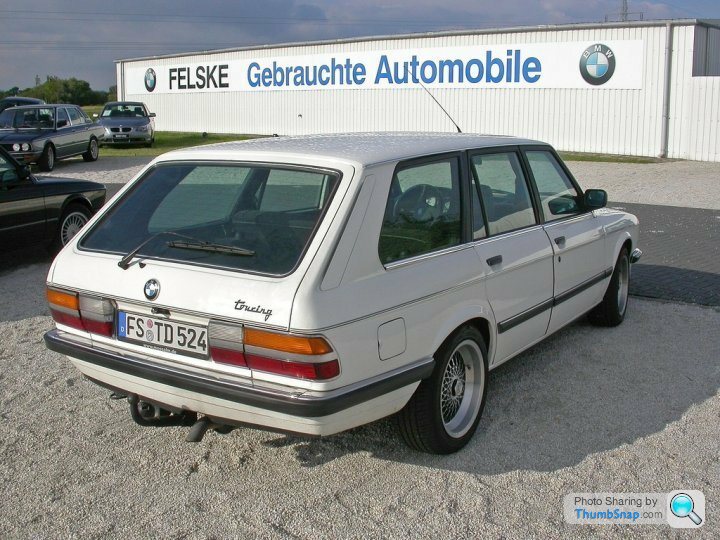

Note that these both have a cut-out in the lower section, encompassing the number-plate and part of the tail-lights, for additional practicality.
Alas, I can't find a photo of the E30 Touring conversion that spawned the factory car, other than one grainy B&W shot of the bare shell - but it looks exactly like the factory car - but even before that, and before the 4-door saloon from which it was converted, 2-door E30s were being converted to rather handsome shooting brakes, using chopped-about Mk1 Golf tailgates.
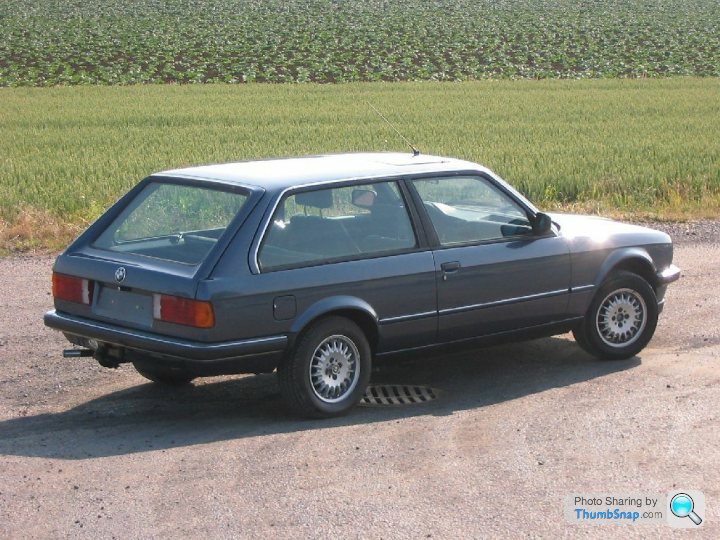
Similar conversions had already been performed on E21s.

Alas, it appears that this glorious 5-door E21 is a Photoshop.
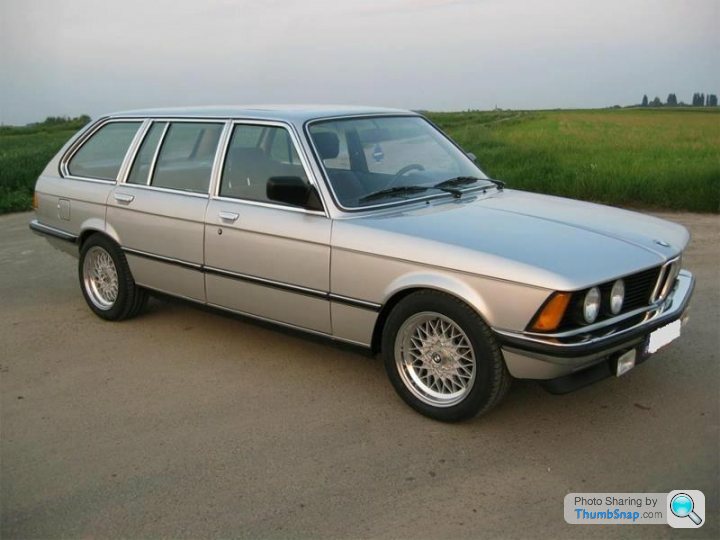
There's also this E32 750iL Touring...
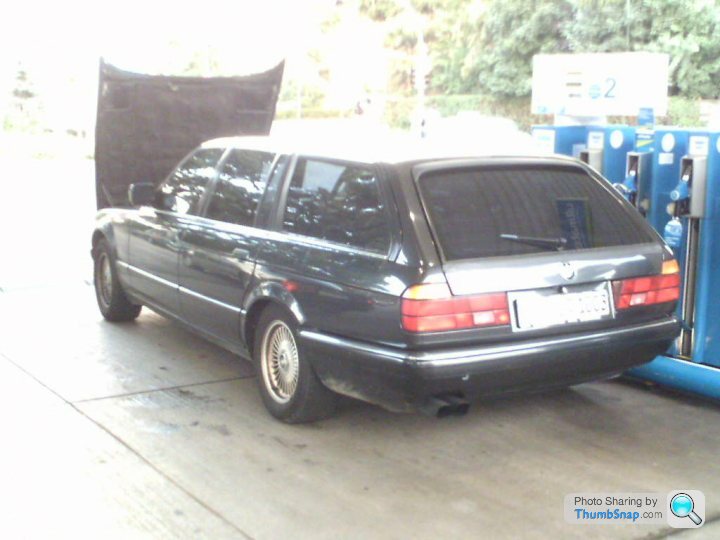
Along not-unrelated lines... Schulz built this rather odd truncated W201 "City Compact" using an S124 tailgate.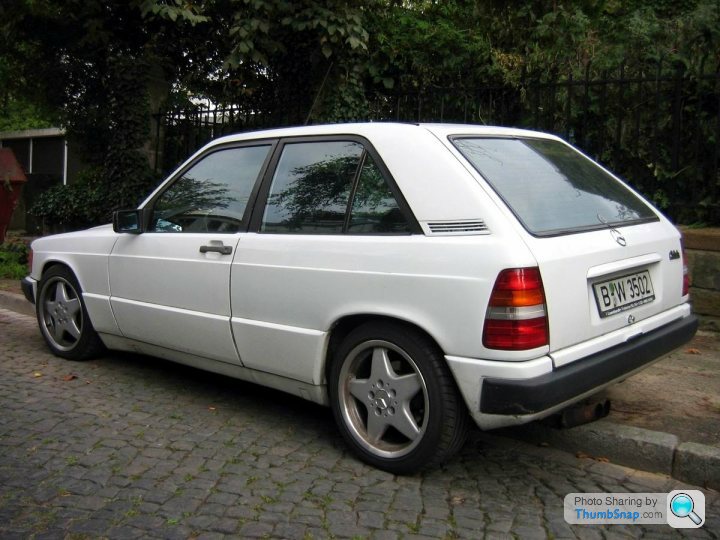
This rather handsome 300SEL 6.3 estate came on the market for the first time in 2011, but sold quickly and doesn't appear to have resurfaced.

I seem to recall a Belgian coachbuilder was responsible for these rather lovely Fintail conversions (of which a large number still exist).

Pollmann of Bremen did a rather better job than Crayford of converting the 450SEL, I think - a bespoke tailgate rather than a cobbled-together one using the saloon's bootlid and a Ford Granada estate tailgate...
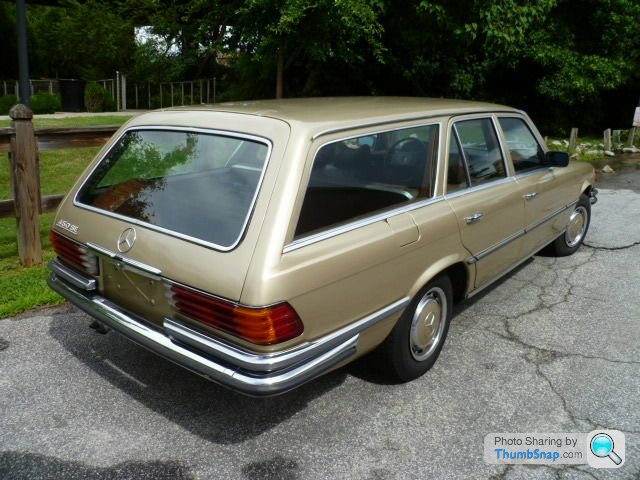
There are numerous different conversions of the W126 S-class around, and I like all of them very much.
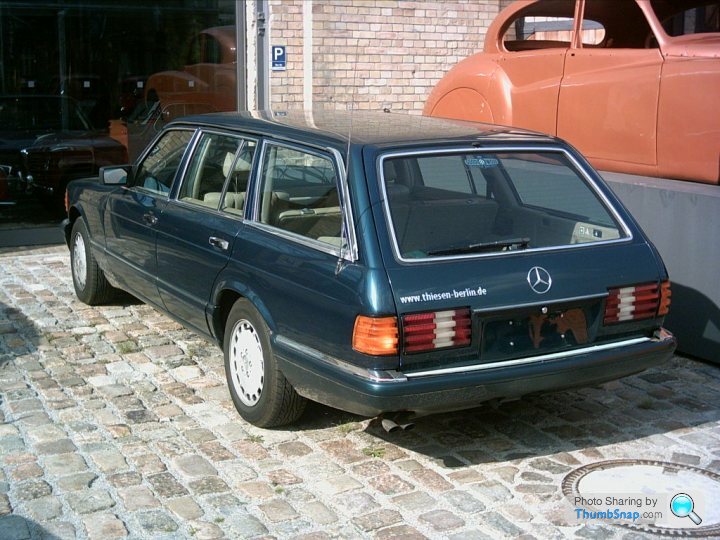
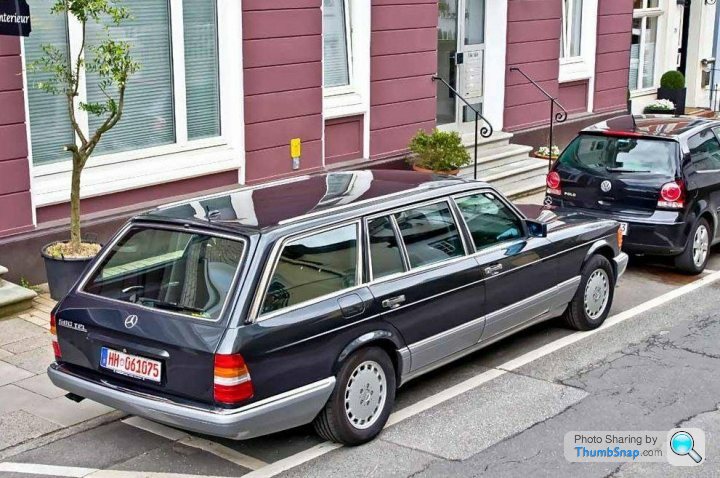
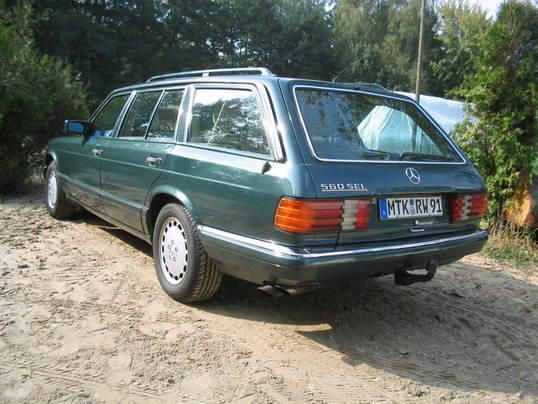
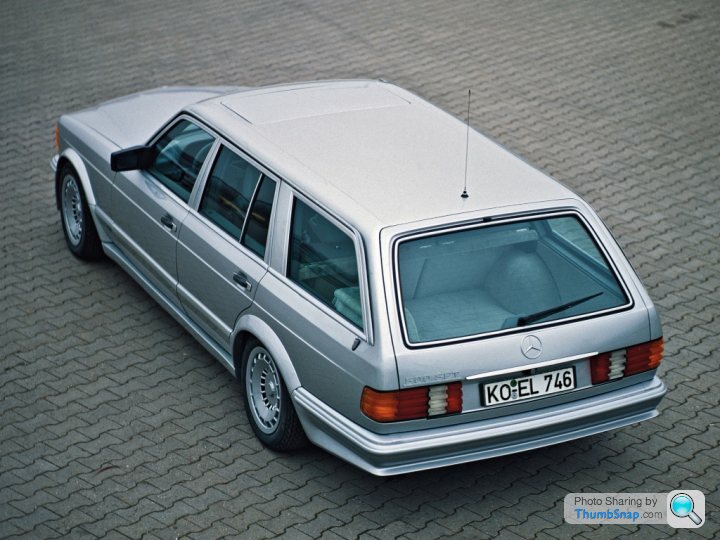
W140s seem to convert quite nicely too, including this standard model...
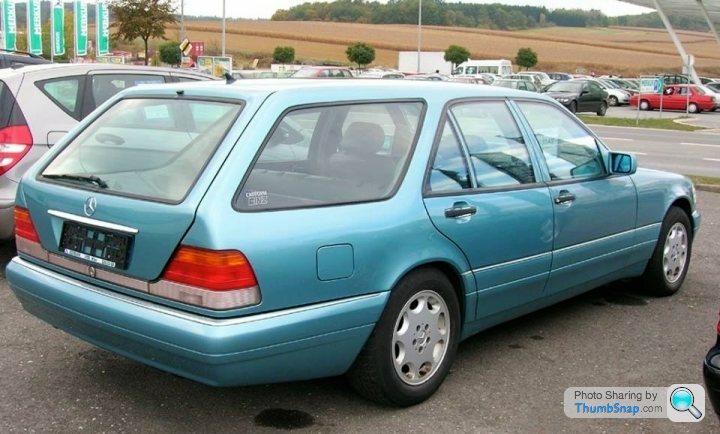
...and this utterly bonkers W140 S73 AMG estate, commissioned (of course) by Prince Jefri of Brunei.
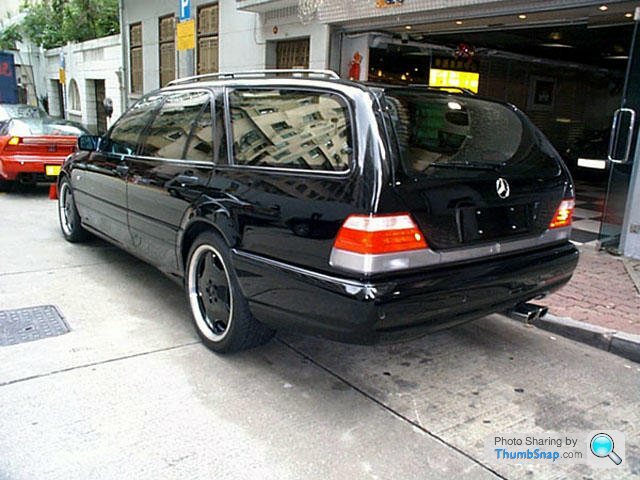
In terms of other British coachbuilt estates, this XJ40 "Hatfield" estate, supposedly built by Jaguar themselves for a company director, and now in the JDHT collection, is rather better than the crude Humberstone conversions (not to mention the wretched Avon SIII hearses!).
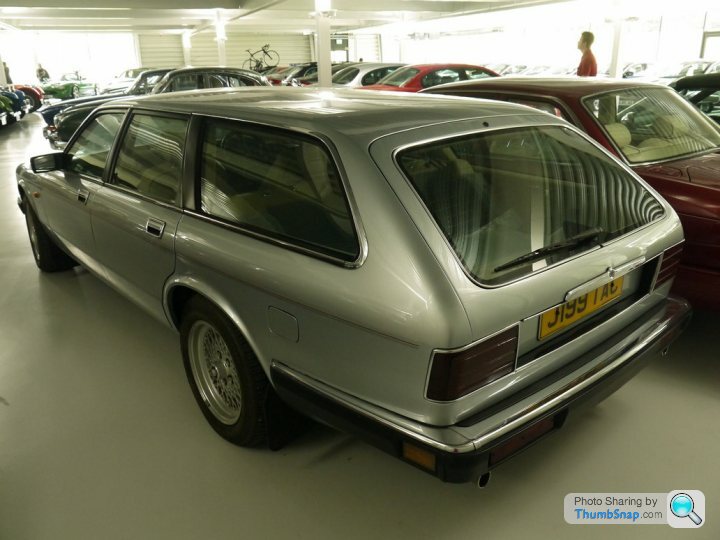
The aforementioned Rolls-Royce Silver Shadow conversions by FLM Panelcraft are reasonably nice - I seem to recall John Entwistle of the Who had one as a dog wagon. This version, by an unknown American coachbuilder, is better-proportioned overall, but the blank tailgate doesn't appeal (I'd want to put the registration plate up there), and like all such conversions, matching the chrome to the slightly drooping rear door window frame is impossible. Volvo had a similar problem with the 144/240 and ultimately had to bodge a solution together. I suspect the vinyl roof is necessary to cover some ugly metalwork underneath.
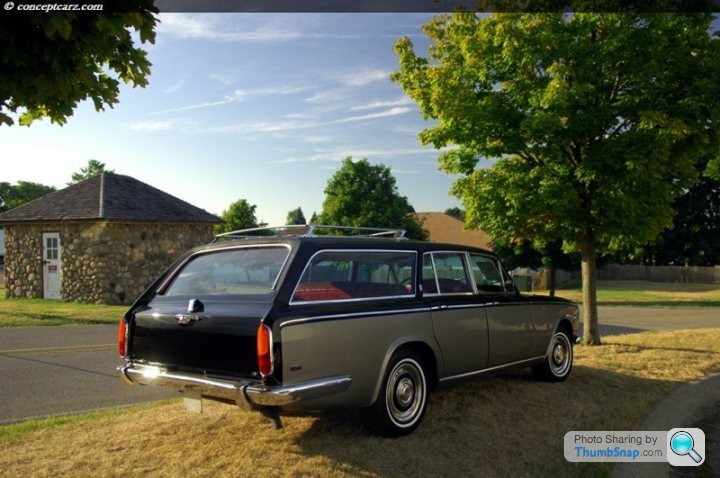
Jankel's Bentley Val d'Isere is quite nice in the right spec, like this silver example. Some are truly hideous - one (a Rolls-Royce) is salmon pink inside and out, another bright yellow out with alternating yellow and red interior! Jankel chopped quite a bit off the rear overhang - some other conversions look very hearse-like for want thereof.
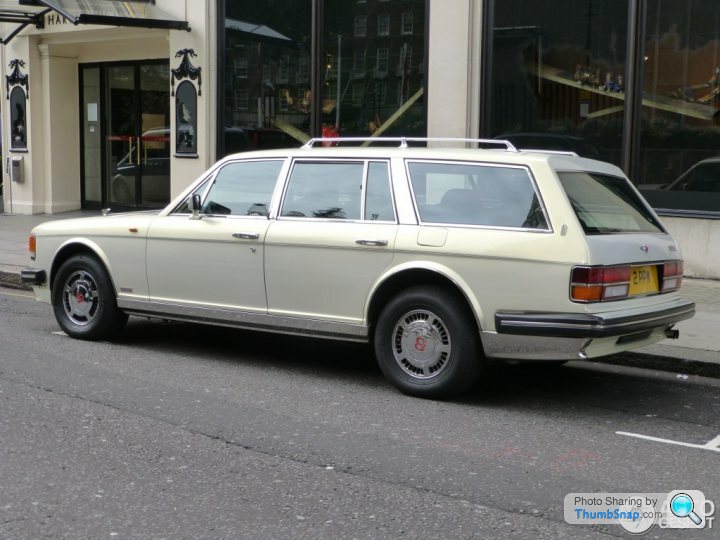

...which, alas, still exists. https://www.drive2.com/b/253873/
This E23 7-series Touring is OK, though the parallel double Hofmeister kink makes my OCD itch. I really like how neatly the wiper has been integrated.

Schulz did some rather good E28 5-series Tourings, none of which has a factory-looking wiper, alas.


Note that these both have a cut-out in the lower section, encompassing the number-plate and part of the tail-lights, for additional practicality.
Alas, I can't find a photo of the E30 Touring conversion that spawned the factory car, other than one grainy B&W shot of the bare shell - but it looks exactly like the factory car - but even before that, and before the 4-door saloon from which it was converted, 2-door E30s were being converted to rather handsome shooting brakes, using chopped-about Mk1 Golf tailgates.

Similar conversions had already been performed on E21s.

Alas, it appears that this glorious 5-door E21 is a Photoshop.

There's also this E32 750iL Touring...

Along not-unrelated lines... Schulz built this rather odd truncated W201 "City Compact" using an S124 tailgate.

This rather handsome 300SEL 6.3 estate came on the market for the first time in 2011, but sold quickly and doesn't appear to have resurfaced.

I seem to recall a Belgian coachbuilder was responsible for these rather lovely Fintail conversions (of which a large number still exist).

Pollmann of Bremen did a rather better job than Crayford of converting the 450SEL, I think - a bespoke tailgate rather than a cobbled-together one using the saloon's bootlid and a Ford Granada estate tailgate...

There are numerous different conversions of the W126 S-class around, and I like all of them very much.




W140s seem to convert quite nicely too, including this standard model...

...and this utterly bonkers W140 S73 AMG estate, commissioned (of course) by Prince Jefri of Brunei.

In terms of other British coachbuilt estates, this XJ40 "Hatfield" estate, supposedly built by Jaguar themselves for a company director, and now in the JDHT collection, is rather better than the crude Humberstone conversions (not to mention the wretched Avon SIII hearses!).

The aforementioned Rolls-Royce Silver Shadow conversions by FLM Panelcraft are reasonably nice - I seem to recall John Entwistle of the Who had one as a dog wagon. This version, by an unknown American coachbuilder, is better-proportioned overall, but the blank tailgate doesn't appeal (I'd want to put the registration plate up there), and like all such conversions, matching the chrome to the slightly drooping rear door window frame is impossible. Volvo had a similar problem with the 144/240 and ultimately had to bodge a solution together. I suspect the vinyl roof is necessary to cover some ugly metalwork underneath.

Jankel's Bentley Val d'Isere is quite nice in the right spec, like this silver example. Some are truly hideous - one (a Rolls-Royce) is salmon pink inside and out, another bright yellow out with alternating yellow and red interior! Jankel chopped quite a bit off the rear overhang - some other conversions look very hearse-like for want thereof.

Edited by RoverP6B on Wednesday 31st January 21:40
Gassing Station | General Gassing | Top of Page | What's New | My Stuff







